Educare Electronic Journal (Revista Electrónica Educare) EISSN: 1409-4258 Vol. 20(1) JANURAY-APRIL, 2016: 1-25
doi: http://dx.doi.org/10.15359/ree.20-2.10
URL: http://www.una.ac.cr/educare
EMAIL: educare@una.cr
[Issue published on January 01, 2016]
Curricular Model of National Institute of Technology of Mexico (Tecnológico Nacional de México)
Curricular Model of National Institute of Technology of Mexico
(Tecnológico Nacional de México)

Arturo Gamino-Carranza1
National Institute of Technology of Mexico,
Directorate of Teaching and Educational Innovation
Mexico, Federal District
d_docencia01@tecnm.mx
Mara Grassiel Acosta-González2
National Institute of Technology of Mexico,
Directorate of Teaching and Educational Innovation
Mexico, Federal District
d_docencia@tecnm.mx
Received November 24, 2014 • Revised July 22, 2015 • Approved November 03, 2015
Abstract. National Institute of Technology of Mexico (in Spanish: Tecnológico Nacional de México) as a decentralized body of the Mexico Ministry of Public Education, which has 266 affiliated institutes throughout the country and serves an enrollment of 556,270 students, seeks to offer top quality education geared towards the needs of the social, scientific, technological, economic, cultural and human development of Mexico. In this context, this article describes the definition of the curricular model used. This model is based on the idea of the syllabus as an integrated training project, which underlies on the concepts of professional training, learning and educational practice, providing sense and meaning to the educational content, tasks of teachers and students, learning and teaching strategies, educational products and processes, as well as, design, implementation, development, monitoring and assessment of academic programs. Currently, this model has designed and innovated 43 study plans with a focus on competence, which multiplied by the number of times offered in 266 schools, added more than 1,300 educational programs across the country. It is worth mentioning that for the design and innovation of these programs more than 35 national meetings were held in Mexico with the involvement of over 4,500 teachers. This model allows a greater flexibility, knowledge and know-how integration, and thus, promote continuous student learning, boosts the development of professional competencies for knowledge application and real problem-solving through the fulfillment of projects and promotion of ethical training as well as the encouragement of environmental care.
Keywords: Curricular design, comprehensive study plan, study plan, higher education, competence.
Resumen. El Tecnológico Nacional de México como órgano desconcentrado de la Secretaría de Educación Pública de México que tiene adscrito 266 institutos en todo el país y que atiende una matrícula de 556.270 estudiantes, busca ofrecer una educación superior de buena calidad, que esté orientada a satisfacer las necesidades del desarrollo social, científico, tecnológico, económico, cultural y humano de México. En este contexto, el presente artículo describe la definición del modelo curricular utilizado; este modelo parte de la idea del currículo como proyecto formativo integrado, el cual es sustentado en las concepciones de formación profesional, aprendizaje y práctica educativa, lo que da sentido y significado a los contenidos educativos, al quehacer del profesorado y del estudiantado, a las estrategias de aprendizaje y didácticas, a los procesos y productos educativos, así como, al diseño, implementación, desarrollo, seguimiento y evaluación de los programas académicos. Actualmente, con este modelo se han diseñado e innovado 43 planes de estudio con enfoque en competencias, lo cuales multiplicados por el número de veces que se ofrecen en los 266 institutos, suman más de 1.300 programas educativos en todo el país; cabe hacer mención que para el diseño e innovación de estos programas se llevaron a cabo más de 35 reuniones nacionales en el territorio mexicano con la participación de más de 4.500 docentes. Este modelo permite una mayor flexibilidad, integración del saber y del saber hacer y, de esta manera, propiciar el aprendizaje continuo de estudiantes, fomentar el desarrollo de competencias profesionales para la aplicación de conocimientos y la solución de problemas reales a través de la realización de proyectos e impulsar una formación ética, así como promover el cuidado del medio ambiente.
Palabras clave. Diseño curricular, currículo integrado, currículo, educación superior, competencia.
Since its inception in 1948, Mexico technological institutes have built an educational profile towards the preparation and training of technicians from an elementary level up to the highest educational degree, in other words, research and postgraduate degree (DGIT, 1998; throughout the history of the institutes it was until 1993 when the Academic Reform in Higher Technological Education took place and 19 national career committees constituted, which were responsible to analyze, evaluate, and integrate the contributions made at national meetings. In this reform, a study plan was considered. Its curricular structure is based on a new model of higher technological education that highlights a generic area with a strong technological support, an area of specialty and a professional residence (fellowship), where the specialties are designed according to each technological institute environmental needs. It is appropriate to point out that this educational model was the result of its own design, the reduction of courses and thus, the possibility of integrating common courses to the 19 careers of the Higher Technological Education Academic Reform.
Towards the first decade of the 21st century, Mexican technological institutes strengthen their educational model and established a model directed to the development of competences: The Educational Model for the 21st Century (SNEST, 2004); which consists of three large dimensions. Philosophical, focusing on the attention of the model in the human being; academic, integrating the reference parameters of vocational training, the learning concept and its conditions, as well as standards of educational practice in technological institutes; and organizational dimension, contributing to fulfilling the purposes of the model and ensuring that the resources be substantially devoted to educational purposes. When discussing about the competences approach in Mexico’s education refers not only to this model aimed at the development of competences, but to several educational institutions in Mexico. For example, the Preschool Reform (SEP, 2004) in which the fundamental purposes of the educational level were established accurately in terms of skills that students should develop from what they already know or are capable of doing, and contribute to articulating preschool education with primary and secondary education; as well as the Reform of Secondary Education (SEP, 2005), in which curricular continuity and its pedagogical articulation of the two educational levels were considered. A conceptual study of the characteristics and traits of competency-based curricular design in Díaz (2009), and an analysis of the main criticisms that represents a competency approach in García, Loredo, Luna and Rueda (2008), are presented.
By the year 2012, the 21st century model for Mexico technological institutes is improved (DGEST, 2012), which refers to a series of approaches that constitute the image-objective, what should be, where learning to learn, learning to get information, learning to contribute, learning to apply knowledge and learning to solve problems are essential professional skills in a society that demands prepared professionals to solve problems, according to Bozu and Canto (2009). This concept of competence goes beyond the cognitive and work areas focusing on the definition and understanding of being competent as a way of life, therefore, it centers on creating competences for life.
This demonstrates that Mexican technological institutes throughout the years have carried out a series of educational reforms with the objective of strengthening its educational model and curricular design in the development of study plans.
National Institute of Technology of Mexico
The National Institute of Technology of Mexico (Presidencia de la República de los Estados Unidos Mexicanos, 2014) is a decentralized administrative body of the Ministry of Public Education (SEP, in Spanish), with technical, academic and managerial autonomy, which has 266 affiliated institutions, of which 126 are federal technological institutes, 134 decentralized technological institutes, 4 regional centers of team optimization and development (CRODE, in Spanish), an Interdisciplinary Center for Research and Teaching in Technical Education (CIIDET, in Spanish) and a National Center in Research and Technology Development (CENIDET, in Spanish) (see Figure 1). In these institutions located throughout the Mexican territory, for the 2015-2016, the school year is estimated to serve an enrollment of 556,270 undergraduate and graduate students, which represents approximately 13% of higher education in the whole country. In order to serve this student population, there are 28,135 professors. National Institute of Technology of Mexico currently offers 43 plans and study programs at the bachelor’s level, which multiplied by the number of times that are offered at 266 institutions result in more than 1,300 academic programs focusing on competences. This educational offer has a great impact in Mexico, since 4 of every 10 professionals in engineering are trained at National Institute of Technology of Mexico (DGEST, 2009a).
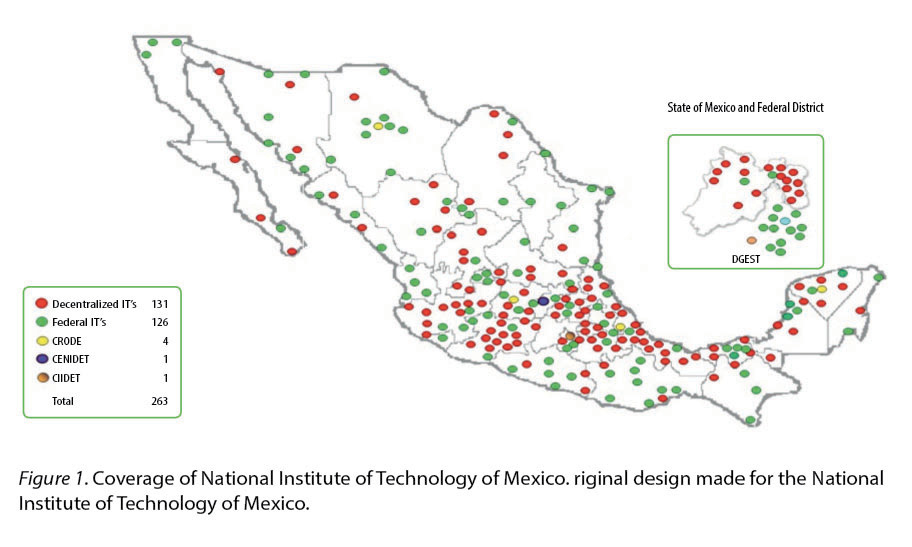
These data show that National Institute of Technology of Mexico is a system of institutions strengthened over the years and is a leading institution in educating engineering professionals in Mexico, which implies that the curricular model used must: a) be consistent with generic training of professionals in engineering, b) be flexible, in other words, adapt to diversity in the specialization areas offered in the whole country, and c) include the use of information and communication technologies.
Curricular Model of National Institute of Technology of Mexico (Tecnológico Nacional de México)
Since its inception, Mexican technological institutes have bring together its teaching, research and management position staff for regional and national meetings in order to combine reflections, experiences and good practices which are organized in documents that give sense and meaning to all the academic work of the National Institute of Technology of Mexico. The products and results of these meetings that move thousands of teachers are geared towards: definition of academic-administrative regulations (DGEST, 2010b); teacher training (DGEST, 2013); professional updating; innovative strategies for learning, for example: (TECNM, 2014) tutorials, and the processes of design, innovation and professional update (see DGEST 2009a; DGEST 2009b; DGEST 2010a). Over the years, National Institute of Technology of Mexico has defined its own curricular model which portrays it when educating engineering professionals in Mexico and which is the core of the current article; however, in the references (Ministerio del Poder Popular para la Educación, 2007; Morán-Beltrán and Méndez-Reyes, 2009; Padilla, 2012; Riera, 2006; Villaruel 2010; Zizumbo, 1999) there are proposals and analysis of different curricular designs and models with an approach in competences for bachelor and graduate levels in Mexico and other countries.
Below the curricular model concepts of the National Institute of Technology of Mexico are described in detail, they have been enriching and focusing on education quality with an approach on professional competences by teacher, research and management position staff in different national meetings from 2009 to date. This definition, based on the concepts of training, learning and educational practice in the educational model, provides sense and meaning to the educational content, the work of teachers and students, the learning and teaching strategies by using information and communication technologies, as well as design and curricular innovation of study plans and study programs currently working in training engineering professionals in Mexico.
The schematic model definition of 43 study plans at National Institute of Technology of Mexico is supported by:
1) Professional training.
2) Professional competences.
3) Teacher and student tasks.
4) Educational contents:
i. Conceptual.
ii. Procedural.
iii. Attitudinal.
5) Curricular organization and integration.
6) Academia.
7) Credits.
A profession is understood as a social practice characterized by complex activities, which is developed based on intellectual abilities, knowledge and ethical attitudes for the one involved and constitutes a way of life. Accordingly, students professional training is the result of an educational process of preparation and social definition of a person, aimed at the construction of conceptual, procedural and attitudinal skills, i.e. performed in social and work environments, see CIDAC (2014); Morán-Beltrán and Méndez-Reyes (2009); as well as the appropriation of cultural and ethical values proposed in a professional profile that corresponds to the social requirements when practicing a profession. The process of professional training goes beyond the school environment; its definition and realization is linked to the development of society.
The process of professional training, according to the educational model of National Institute of Technology of Mexico is directed to the development of professional competences, which are defined as “the integration and strategic implementation of expertise, procedures and attitudes necessary to solve problems, with an ethical, efficient, and relevant performance in heterogeneous and changing business scenarios” (TECNM, 2014, p. 8).
This requires that the work of faculty and students is a joint, continuous and complex activity, in which teachers: a) foster learning environments and scenarios closer to reality aimed at problem solving using information and communication technologies (e.g., see Ávalos, 2008; Suarez, Almerich, Gargallo & Aliaga, 2013), b) dominates innovative strategies that allow to work with the educational content proposed in the study programs, and c) achieves the objectives and assesses student academic performance. Faculty, through their academic participation, develops a progressive appropriation of science, technology and humanities contents; build knowledge, develop skills and assume attitudes.
The following definitions related to educational contents (conceptual, procedural and attitudinal) are obtained from DGEST (2012, p. 41), where it is mentioned that when educational contents organize in curricular levels “with logical and epistemological criteria constitute significant and structured sets of knowledge called study plans for the training and development of professional competences”; “[these] study programs incorporate contents of conceptual, procedural and attitudinal character current, relevant and timely, consistently combined, in order for didactic activities to enrich and accomplish synergistic results” (DGEST, 2012, p. 40).
- The conceptual contents or knowledge are theoretical constructs (theoretical construction to solve a particular scientific problem) among those include: concepts, definitions, categories, laws, principles, postulates, theorems, and models. They have a disciplinary nature and allow describing, explaining, predicting and understanding events, phenomena, relations and processes of professional training, practicing the profession, as well as its evolution and significance.
- The procedural contents or know-how are executions of processes, methods, techniques, and, of course, procedures related to the domain and use of different languages, algorithms and heuristics, which are crucial strategies of thought and action for creating and designing of devices, machines and technological objects in general; the design, formulation, evaluation and development of projects of various kinds; the treatment of production and technological problems; use and selection of materials, machines and tools; the assembly of equipment and facilities...
- The attitudinal contents or know how to be are common guidelines of ethical action that are present in the application of conceptual and procedural content, as well as in the performance of the profession. (DGEST, 2012, p. 41)
The curricular organization and integration for the National Institute of Technology of Mexico suits:
A group of structuring elements that characterize all of its academic work and enable to give sense and meaning to the activities of people, processes and results that give life to [their] educational [training] project. This study plan is considered a comprehensive training, subjects referred to ethical training, as well as constituting a concern for the sustainable development of its environment and research. (TECNM, 2014, p. 91)
The main actors to carry out a quality professional training consists of teachers, this includes collegiate bodies called Academies, which are instituted instances to participate in the definition and development of key projects in the areas of teaching, research, entailments and dissemination of culture; as well as in the processes of design, implementation, development and curricular evaluation of academic programs. This academic work, collectively, interdisciplinary, responsible and committed, guarantees the validity, relevance and updating of the educational contents, training of students and objectives of the National Institute of Technology of Mexico or any institution; for example, in Jiménez (2002) an academic experience in curricular design is featured.
In a curricular model, another important aspect to consider are credits, the National Institute of Technology of Mexico in its approach by competency adopted an Academic Credit Assignment and Transfer System (SATCA, in Spanish) that allows a set of simple and unambiguous criteria to assign a numeric value to the learning activities of students, set out in its study plan in order to accumulate and transfer credits, as well as from other higher education institutions, referred to as multi-accreditation (Asociación Nacional de Universidades e Instituciones de Educación Superior [ANUIES], 2007). SATCA defines credit operationally as the measurement unit of the academic work of students in the teaching criteria, supervised professional practice work and other individual or independent learning activities. In Table 1 the alignment of academic credit allocation criteria from the study plans of the National Institute of Technology of Mexico is presented.
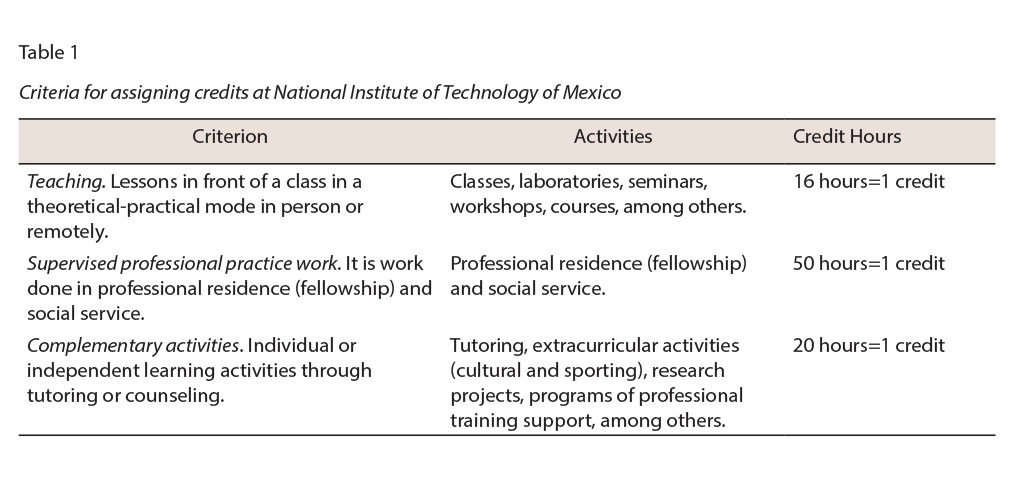
Structure of Study Plans of the National Institute of Technology of Mexico
There are several ways to articulate or design the study plan (Zabalza, 2012). This section presents the plans and study programs of National Institute of Technology of Mexico, geared to training in the engineering area, which are based on a flexible curriculum design that enables the systematic and continuous adaptation to the requirements of local, regional and national development; permanent inclusion of scientific and technological progress; comprehensive training of the student body; establishment of strategies that promote training professionals that exhibit creativity, entrepreneurship and competitiveness. Presently 43 study programs have 260 credits, distributed in six curricular moments aligned with the three SATCA criteria:
1) Generic structure (including common subjects).
2) Specialty.
3) Social service.
4) Professional residence (fellowship).
5) Complementary activities.
6) Comprehensive degree.
The above is shown in Table 2 where, as seeing, generic structure and specialty block should be adjusted to the range established, so when adding the other blocks always total 260 credits.
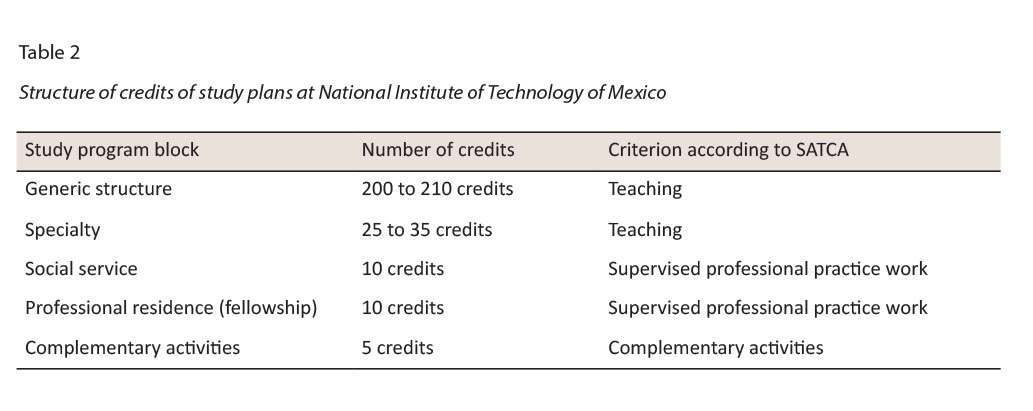
According to Table 1, where the amount of hours by credit and distribution are set for Table 2, all National Institute of Technology of Mexico study plans are made up by: a) 235 credits on the teaching criterion between the generic structure and specialty, which is equivalent to 3,760 hours; b) 20 credits on the supervised professional practice criterion between social service and professional residence, which is equivalent to 1,000 hours and c) 5 credits on the complementary activities criterion, which is equivalent to 100 hours. From the above, it is concluded that the credit structure is 260 which is equivalent to 4,860 effective hours of professional training for the student body during nine semesters, the above is shown graphically as blocks on Figure 2.
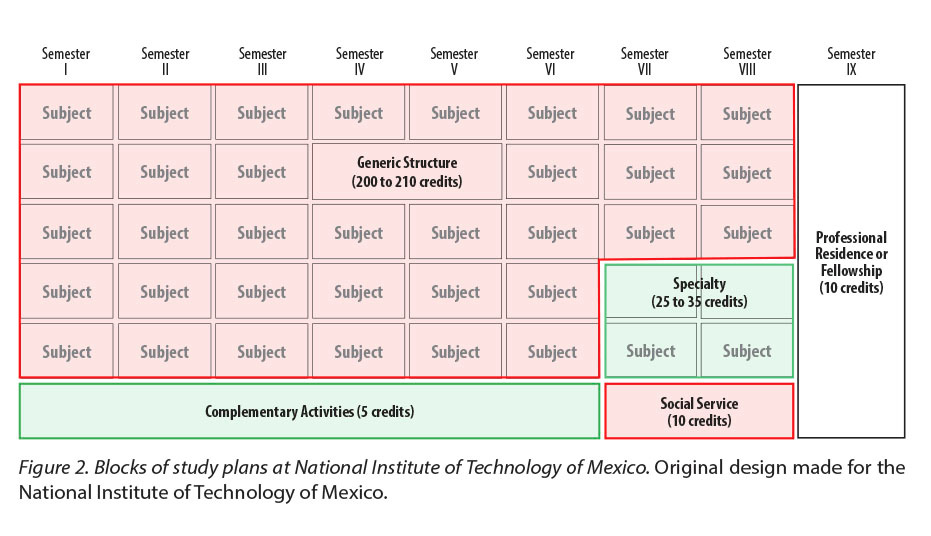
The generic structure is defined as the curricular space consisting of a set of subjects in the 200 to 210 credit range based on SATCA teaching criteria, which contains basic, substantial and necessary aspects to train professionals. In this generic structure the study plan includes 10 subjects named common subjects, which are displayed in Table 3; the term “common” is to emphasize that these subjects are compulsory in the 43 study plans.
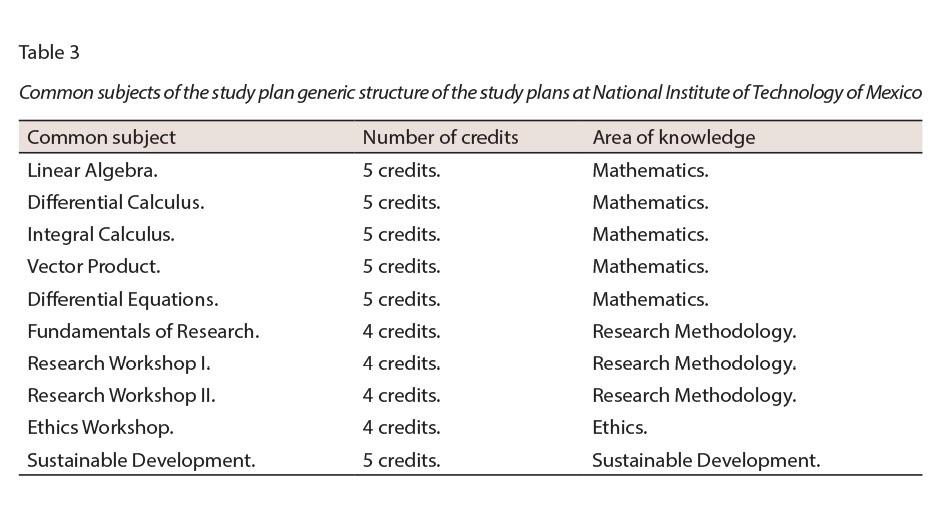
Common subjects imply that all study plans of National Institute of Technology of Mexico have 46 permanent credits in its generic structure that cannot be modified and that all graduates must have taken these subjects. The way in which the rest of the generic structure of each study plan is defined is through a methodology of subject program development focused on competences at national meetings carried out with teaching, research and managerial staff at the Mexico National Technology and governmental and business sectors which are invited to these meetings (DGEST, 2009c; DGEST 2010a; García, 2009).
An important aspect of these subject programs consists of practices that students must develop in classrooms, workshops, laboratories and social and productive environments (for example, refer to Ibáñez, 2007, where practices are proposed as core in their curricular design). These are essential academic activities in their training process which relate conceptual knowledge with know how; they are educational scenarios that encourage participation and critical activity to achieve meaningful learning and the development of professional competences.
The comprehensive training of students is complemented through a set of actions, tasks, activities and exercises in a 5 credits curricular area known as Complementary Activities. The following are considered complementary activities: tutoring, after-school activities, research projects, participation in academic events, labor productivity, entrepreneurship, encouraging reading, building prototypes and developing technology, environment conservation and participation in editions, or those the institution defined to benefit the development of professional competences. These activities encourage multiculturalism in the student body, i.e. experiences to exchange ideas with people from all over the world, practice languages, access to better job opportunities, and discover food, culture and history of other countries. For example, refer to Rodríguez (2007) where a statistic that highlights school participation in preserving the culture as an important activity in the comprehensive training of the student body is shown.
Social Service is a 10 credit area of the core curriculum, which is carried out through “training [and] compulsory activity... allowing students to professionally serve the society where they belong and repay the benefits received through their training, in other words, providing service to society” (TECNM, 2014, p. 20).
Specialty “is defined as a curricular area consisting of a set of subjects [in a 25-35 credit range] that completes the higher training of future professionals. It provides greater flexibility to each study plan and timeliness to each academic project. In addition, it serves local, regional, national and international emerging technological trends for each area of knowledge, and ensures current and relevant training” (TECNM, 2014, p. 20). The Specialty is assemble according to the study plan generic structure and its educational contents are defined based on a study of demands of the productive sector of each institutes’ region; for example, for the study plan in renewable energy engineering at a college in Northern Mexico, a Solar Energy Specialty is more feasible than at a technological institute in Southern Mexico where a Wind Energy Specialty is best due to the difference in weather conditions and infrastructure in the country. The previous allows offering a range of specialties with different orientation for graduates of National Institute of Technology of Mexico. The Academies are constantly updating the educational contents of this curricular area, according to the current demands and trends of the region and the country. The Specialty is not only a distinctive feature of the curricular model of National Institute of Technology of Mexico, but it is also a distinctive feature of every technological institute which offers students competences aligned to the current demands of the productive sector. Finally, an institute that offers several specialties provides greater flexibility to students to develop professional competences, for example, see Figure 3, where three Electromechanical Engineering specialty careers are mentioned.
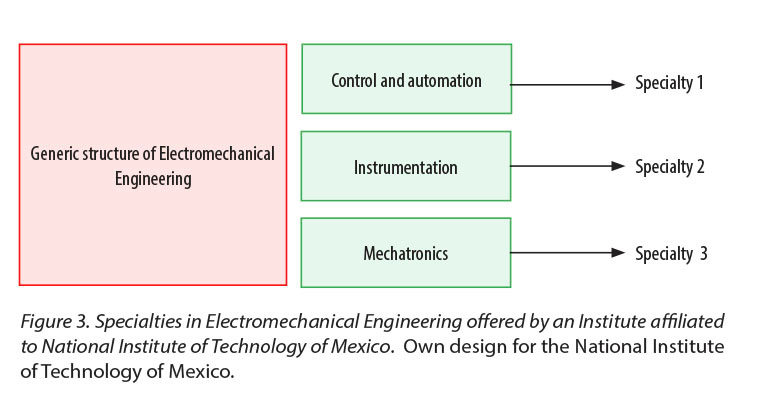
Professional Residence or fellowship is a 10 credit curricular space in which the student body deal with a particular context problem of social and productive reality, proposes an alternative solution and applies his/her knowledge, in other words, it is a theoretical, analytical, reflective, critical and professional project, in which the student body significantly integrate the learning outcomes achieved and the experience gained in a specific workplace and professional area. This process is part of the study plan and complements the training to practice their profession at the end of their program. Within the semester, students regularly secure 500 hours in the industry or in a research center solving a specific context problem in the following areas: a) social/productive sectors of goods and services, b) innovation and technological development, c) research, d) equipment design and construction and e) scientific or research summers.
National Institute of Technology of Mexico offers a comprehensive degree process which “belongs to the study plan and is carried out throughout professional training [through a comprehensive project], in which the student applies knowledge, methods and procedures learned as well as relates practice with theory in a socially and professionally useful project” (TECNM, 2014, p. 20). This process is of great importance in order to verify the ability to integrate theoretical and practical demands that professional practice raises and, as a result, allow to obtain a professional degree to practice his/her activity in the productive sector, goods or services. When discussing about comprehensive degree, it emphasizes that the student body, during its professional training, through a comprehensive project (which could result in: thesis, reports on professional residence or fellowship experience, dissertation, patents, among others) accomplishes his/her professional degree; further, it is not necessary to finish the study plan so that at the end students choose an option to obtain their professional degree; this difference is graphically shown on Figure 4, in case of preparing a dissertation.
Although on Figure 4 it is not mentioned, it is graphically shown that carrying out the dissertation (green color table) represents a certain additional time -nine semesters for its fulfillment. In Case a) the time varies depending on the competences of the graduate person and conditions to develop the work, however, it is a fact that more than nine semesters are necessary to obtain a degree; while for Case b) within the nine semesters, students use time to perform the dissertation and when concluding the syllabus obtains his/her professional degree which provides the opportunity to become part of the industry immediately.
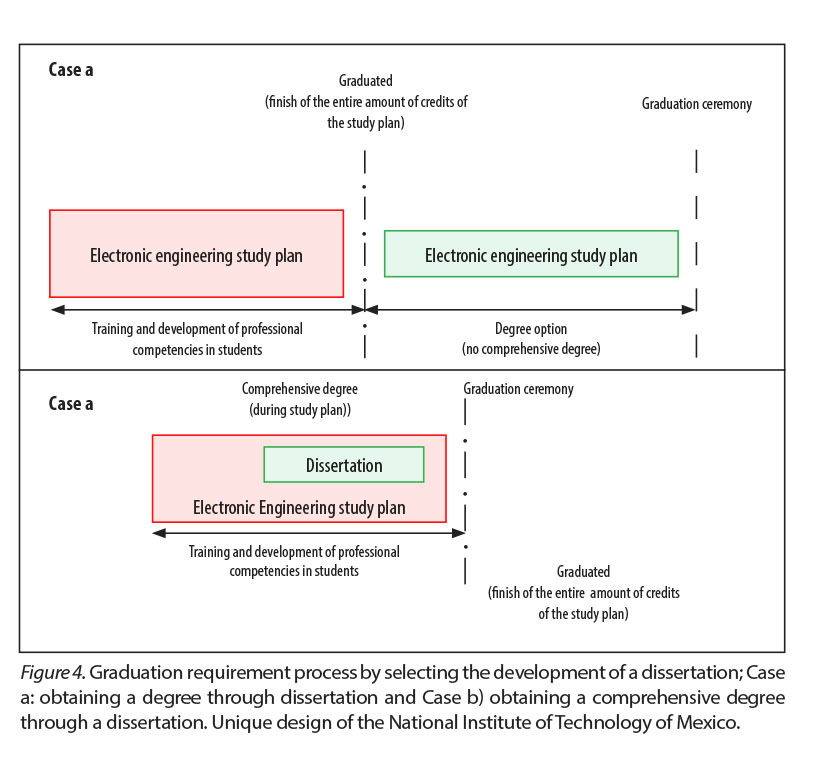
Well, what if a student for causes or circumstances of force majeure, that are not within his/her reach, prevent him/her to conclude his/her study plan? At a higher level, study plans for a bachelors’ degree may consider a lateral exit that provides students the recognition of a group of generic and specific competences developed during their training for their immediate inclusion to the productive sector of goods and services. The lateral exit provides him/her an option to demonstrate he/she have reached basic competences during his/her stay in the institution, through a degree, which will help him/her make certain the achievements of such competences. In Estévez et al. (2003) deepens about a program called “surpass” which emphasizes the importance of competences to fit into the labor market.
Ideally, a student entering National Institute of Technology of Mexico, during the first six semesters obtains a solid education in basic competences through subjects in the generic structure (including common subjects) and parallel to this in this period his/her education iscomplemented with activities, preferably tutoring or counseling through complementary activities; by the seventh semester the student starts a more specific and specialized training in a particular area of knowledge of his/her study plan through specialty courses, while continuing to train and develop skills in the subjects of the generic structure. In addition, he/she develops projects that contribute to the development of society through Social Service. At the end of the eighth semester, the student has completed his/her courses of the study plan, including specialty subjects, has given back to society through Social Service and has aroused interest in other activities that contribute to his/her professional training through Complementary Activities. Now, it is time to start a theoretical-practical project that will solve a problem of specific context in the industry within one semester, and put into practice all the competences acquired in his/her study plan. As previously explained, carries out a comprehensive project in order to obtain a professional degree during nine semesters, so when completing his/her Professional Residence (260 credit accreditation), performs his/her official ceremony to obtaining a comprehensive degree at National Institute of Technology of Mexico (see Figure 5).
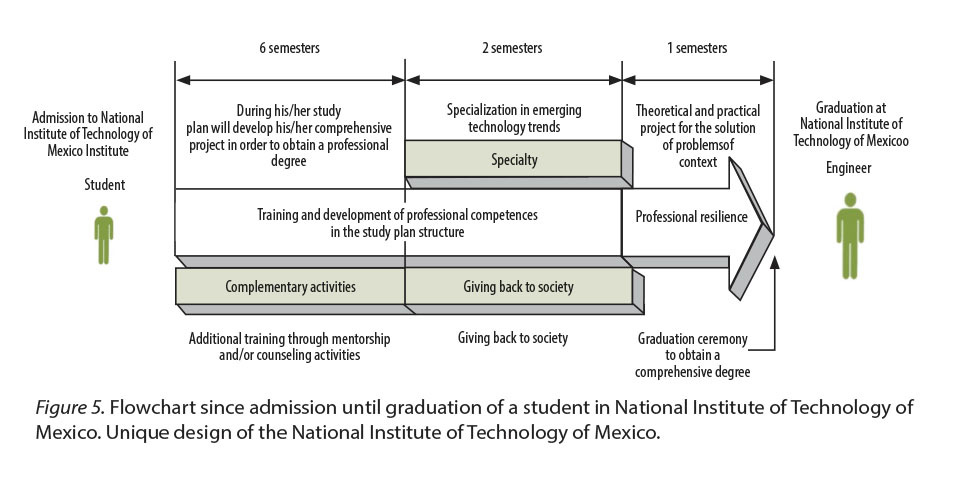
Implementation of Curricular Model of National Institute of Technology of Mexico (Tecnológico Nacional de México)
In this section, the process from 2009 to date is presented in a very concrete way, through which the curricular design and innovation for training and development of professional competences in the study plan of National Institute of Technology of Mexico was carried out, i.e., see Díaz (2006) where it is mentioned that the approach by competences represents an innovation; this effort focuses on providing a comprehensive education that balances shaping citizen values, developing competences and acquiring knowledge. This process resulted in educational programs with an approach on more flexible competences and they include a comprehensive character of knowledge and of know-how in order to reflect the changes occurring in the professions, sciences, humanities and technology (Tünnermann, 2003), and in this way, promote student learning, foster the development of professional competences to apply knowledge and solve problems through projects (Badilla, 2009); promote language management and logical thinking, highlight the important role of teachers and promote ethical training; learn and strengthen the multiple cultures that make up the country; as well as promote environmental care.
The process carried out by National Institute of Technology of Mexico and its 266 institutions to implement the model described in the previous section was developed in three basic phases: a) Information about the development of professional competences. b) Curricular design and innovation for professional competences training and development. c) Curricular consolidation and development of professional competences.
The first phase was conducted during the January-February 2009 period throughout eight regional meetings geographically distributed in North, Central and South Mexico, with a total of 230 technological institutes, (CIIDET and CENIDET) gathering 2,293 participants with the following objectives:
1) Get managers and directors, assistant academic director, heads of academic departments, academic presidents and faculty involved in the process of training and development of professional competences.
2) Define function, organization and participation of the academies of the institutes involved in the process of curricular designing and updating; as well as, in the implementation and development of academic training programs and development of professional competences.
3) Present the methodology for curricular design and innovation for training and development of competences, as well as updating the study plans of National Institute of Technology of Mexico careers.
The main agreement derived from these meetings was the participation of directors and academic staff of 266 institutes to establish proposals of curricular design and innovation, in a term not greater than six months of the TecNM study plans, using an approach directed to the development of professional competences.
During the August-December 2009 period, 170 technological institutes and 800 teachers participated in the second phase through thirteen national meetings of curricular design and innovation for training and development of professional competences of all careers. Accomplishments:
1) Recognition and analysis of the state of the art in various fields of knowledge linked to the careers offered at National Institute of Technology of Mexico.
2) Determining the predominant and emerging practices develop in each one of the fields of science and technology assisted by academic programs.
3) Development of an innovative curricular proposal by academic program that meet the sectorial educational policy guidelines and the requirements of the indicators analyzed in the study of social and educational reality.
4) Carrying out curricular design and innovation to train and develop professional competences of the careers.
5) Definition of didactic instrumentation course programs.
6) Establishment of strategies and mechanisms to carry out a follow up of the curricular plans and programs of study.
At the end of these activities, each study plan is structured based on a social dimension that is constituted by the general objective of the career and professional profile; a conceptual dimension consisting of psychological logic and pedagogical organization of the contents of learning and didactic dimension established by objectives, learning strategies, teaching activities, practices and evaluation activities. The social dimension of a career takes shape with the development of the career general objective and professional profile, which once defined, constitutes the focal point of the work involved in a career design. “The professional profile and the overall objectives are defined based on the study of the social and educational context... [and] consists of a group of professional performances. A professional performance involves explaining the skills and competences [specific and generic] that graduates will put at stake in their professional work” (DGIT, 2002, pp. 27-28). Based on the analysis and definition of the conceptual structure of the career, the significance of knowledge and ephemeral nature of others stand out, in the light of the previously defined professional profile. In addition, it gives the possibility to avoid the encyclopedism and repetition of unnecessary contents. The conceptual structure, rather than conceived as a linear and hierarchical list of terms, it was created as sets of dynamic and complex relationship of concepts which, according to this analysis, formal boundaries and borders disappear, become passable, achieving conceptual restructuring based on a career, for example, see González and Morales (2006) showing a case study of why the connection among courses is important.
The main agreement of the participants during this phase was the establishment of the concept of: a) graduation profile, b) objective of the study plan, c) course comprehensive programs and d) study plan. Persons involved in their academies and institutions committed to socialize the previous conceptual result for its improvement, based on this feedback developed the contents during a period of three months, which will serve as input to the third phase.
The third and last phase which took place during the period of January to June 2010 through ten National Curricular Consolidation Meetings for Training and Development of Professional Competences of all careers, with the attendance 160 technological institutes and 700 professors and teachers and having as their primary goal reviewing and validating the conceptual development of the results obtained in the second phase providing, as a result of all this effort, a definite study program and syllabus currently offered at the National Institute of Technology of Mexico.
When National Institute of Technology of Mexico carries out the design of a new study plan, it carries out the process using the phases described. It was not until the period 2012-2014, after 2010, when seven study plans were designed with the involvement of 40 technological institutes and 420 teachers in 14 national meetings.
From 2009 to date for the design and curricular innovation of all its study plans and programs, National Institute of Technology of Mexico has made over 45 national and regional meetings throughout Mexico, mobilizing more than 4,210 teachers. This implies a great effort to offer a technological higher education of quality in Mexico through 43 study plans as shown in Table 4.
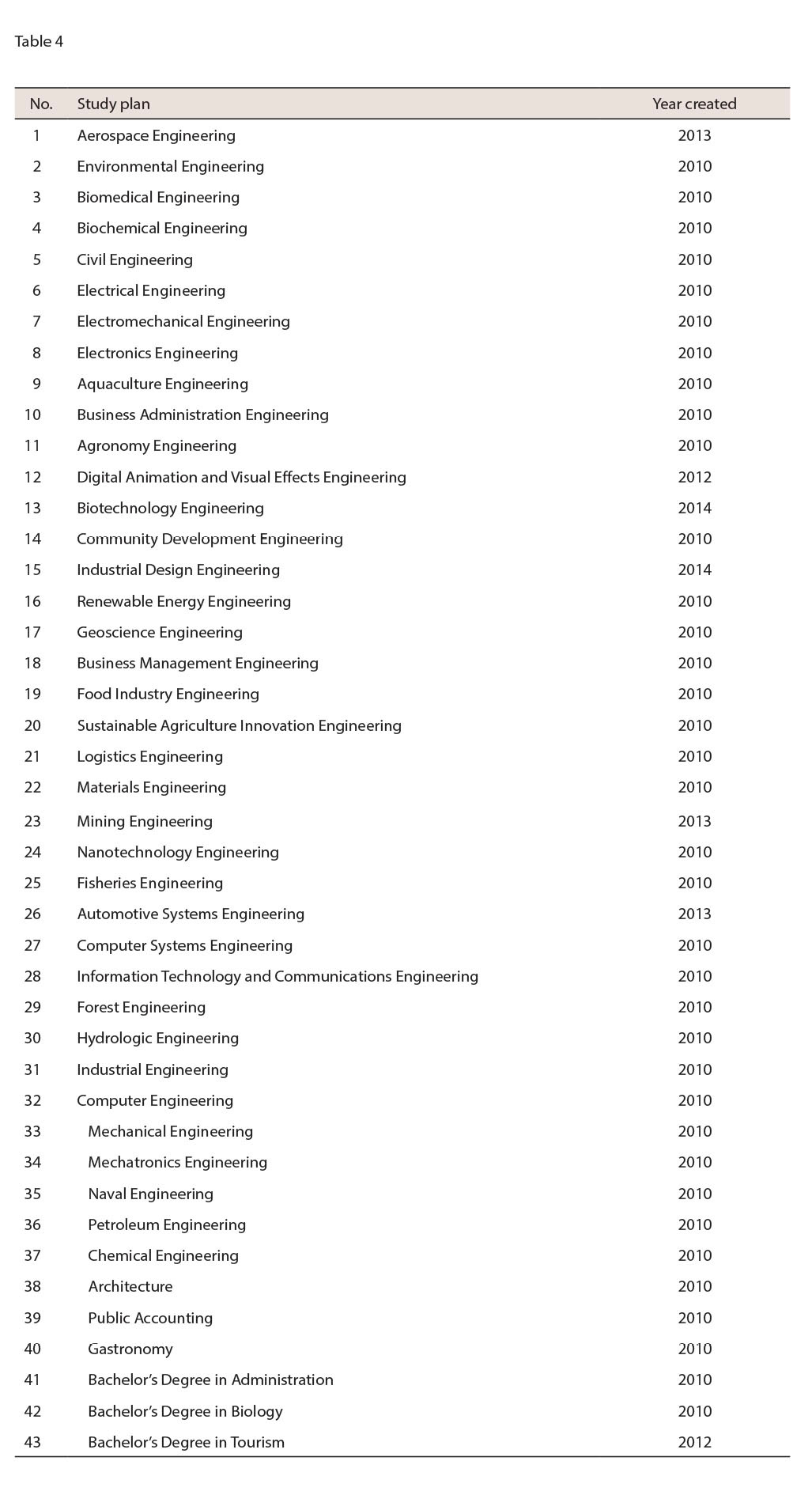
Findings
The curricular model presented by means of this document is flexible and incorporates the integral character of knowledge, know-how and self-being. This model of National Institute of Technology of Mexico is used for curricular design and innovation of all its plans and programs of study with a focus on professional competences. The National Institute of Technology of Mexico creates its study plans in order to meet the needs of the social, scientific, technological, economic, cultural and human development of Mexico. This educational offer is fulfilled by means of its 266 technological institutes distributed throughout the country, for the 556,270 students at undergraduate and graduate levels.
The model presented covers the philosophical aspects of the technological institutes’ life, as well as large blocks that comprise it, in a very special way the Specialty and Professional Residence are distinctive curricular aspects of the National Institute of Technology of Mexico and allow constant updating of the academies in technologies and emerging practices of the different knowledge areas and inspire a more specialized professional training through the resolution of context problems, associating this with greater flexibility in educational opportunities and highly qualified human capital training in different areas of the engineering knowledge. On the other hand, supplementary activities are a small curricular space that allows learning based on significant experience and national or international cultural, sports and social nature activities, which complement the professional training of the student throughout his/her study plan. The curricular model includes the training and development of competences laid down in the professional profile at a perfect time of nine semesters and encourages the comprehensive degree; therefore, this model aims to increase completion rates. Also, experience and basic statistics of the whole process of curricular design and innovation for training and development of professional competences, conducted from January 2009 to date, on 43 careers offered by the National Institute of Technology of Mexico throughout its 266 institutions in the whole country was presented very concretely.
Finally, the curricular model of 43 plans and programs of National Institute of Technology of Mexico are characterized by:
01) Development and training of professional competences for life.
02) Greater flexibility.
03) Transfer and mobility easiness through the establishment of a mutual system of recognition and credits conversion between institutions (SATCA).
04) Comprehensive degree in the process of training of students (comprehensive degree project).
05) Development of competences in the area of mathematics, research methodology, ethics and sustainable development (common subjects).
06) Specialization in more specific competences in the emerging and cutting-edge (specialty) knowledge areas.
07) Application of professional competences through solving a real context problem (professional residence).
08) Multiple accreditation (SATCA allows this transfer of credits).
09) Multiculturalism (promoted through complementary activities).
10) Usage of information and communication technologies in the development of professional competencies through learning environments and scenarios as close to reality as possible and aimed at solving problems, using information and communication technologies.
Derived from this curricular model, currently National Institute of Technology of Mexico is defining the evaluation tools which allow measuring the impact of the model in its graduates of 43 plans and programs of study beginning in 2015. In contrast, through specialty and professional residence it is intended to incorporate innovative curricular strategies that allow the strengthening of the development of professional competences through modular integrating projects and dual education school-business partnerships. Furthermore, the teaching evaluation instruments being designed allow a feedback for continuous improvement of the model. All of the above will take place with the use of information and communication technologies through the specific development of software systems.
References
Asociación Nacional de Universidades e Instituciones de Educación Superior (ANUIES). (2007). Sistema de asignación y transferencia de créditos académicos [Assignment and Transfer Academic Credits System]. Mexico: Author. Retrieved from http://www.uacj.mx/sa/ie/Documents/SATCA/SATCAExtenso.pdf
Ávalos, G. (January-June, 2008). El uso de la tecnología de la información y la comunicación y el diseño curricular [The use of information and communication technology and curricular design]. Revista Educación, 32(1), 77-97. Retrieved from http://www.redalyc. org/pdf/440/44032107.pdf
Badilla, E. (2009). Diseño curricular: De la integración a la complejidad [Syllabus Design: From Integration to Complexity]. Revista Actualidades Investigativas en Educación, 9(2), 1-13. Retrieved from http://revistas.ucr.ac.cr/index.php/ aie/article/view/9529
Bozu, Z., & Canto P. J. (2009). El profesorado universitario en la sociedad del conocimiento: Competencias profesionales docentes [University Faculty in the Knowledge Society: Faculty Professional Competences]. Revista de Formación e Innovación Educativa Universitaria, 2(2), 87-97. Retrieved from http://refiedu.webs.uvigo.es/Refiedu/Vol2_2/ REFIEDU_2_2_4.pdf
Centro de investigación para el desarrollo (CIDAC). (2014). Encuesta de competencias profesionales 2014: ¿Qué buscan –y no encuentran– las empresas en los profesionistas jóvenes? [Survey for Professional Competences 2014: What companies are looking for - and not found - in young professionals?]. Mexico: Author. Retrieved from http://www.cidac.org/esp/uploads/1/encuesta_competencias profesionales_270214.PDF
Díaz Á. (2006). El enfoque de competencias en la educación. ¿Una alternativa o un disfraz de cambio? [Competences Approach in Education. An alternative or a change of costume?]. Perfiles Educativos, 28(111), 7-36. Retrieved from http://www.scielo.org.mx/pdf/ peredu/v28n111/n111a2.pdf
Díaz Á. (2009). Diseño curricular por competencias. Apertura de temas que significan un regreso a los viejos problemas de la educación [Curricular Design by Competences. Opening of topics that mean a return to the old problems in education]. En Memoria Electrónica del X Congreso Nacional de Investigación Educativa [In electronic memory of the 10th National Congress of Educational Research] (pp. 1-13). Veracruz: Consejo Mexicano de Investigación Educativa. Retrieved from http://www.comie.org.mx/congreso/memoriaelectronica/v10/pdf/area_tematica_02/ponencias/1009-F.pdf
Dirección General de Educación Superior Tecnológica (DGEST). (2009a). Anuario Estadístico 2009 [Statistical Yearbook 2009]. Mexico: Author.
Dirección General de Educación Superior Tecnológica (DGEST). (2009b). Guía para la instrumentación didáctica de los programas de estudio para la formación y desarrollo de competencias profesionales [Guide to the Didactic Implementation of Study Plans for Training and Development of Professional Competences]. Mexico: Unpublished manuscript.
Dirección General de Educación Superior Tecnológica (DGEST). (2009c). Programa de diseño e innovación curricular para la formación y desarrollo de competencias profesionales. [Curricular Design and Innovation Program for Training and Development of Professional Competences]. Mexico: Unpublished manuscript.
Dirección General de Educación Superior Tecnológica (DGEST). (2010a). Documento de trabajo para las reuniones nacionales de consolidación de las carreras del SNEST México [Working paper for the national consolidation meetings of SNEST Mexico careers]. Unpublished manuscript.
Dirección General de Educación Superior Tecnológica (DGEST). (2010b). Lineamientos academico-administrativos, versión 1.0. [Administrative/Academic Guidelines, version 1.0]. Mexico: Author. Retrieved from http://tecnm.mx/academica/ normateca-de-la-direccion-de-docencia
Dirección General de Educación Superior Tecnológica (DGEST). (2012). Modelo educativo para el siglo XXI: Formación y desarrollo de competencias profesionales [Educational Model for the 21st Century: Professional Competences Training and Development]. Mexico: Author. Retrieved from http://www.itmexicali.edu.mx/informacion/modelo_educativo.pdf
Dirección General de Educación Superior Tecnológica (DGEST). (2013). Diplomado para la formación y desarrollo de competencias docentes (DFDCD) [Associate Degree for the Training and Development of Teaching Competences]. Mexico: Author. Retrieved from http://tecnm.mx/convocatorias/diplomado-para-la-formacion-y-desarrollo-en-competencias-docentes - dfdcd
Dirección General de Institutos Tecnológicos (DGIT). (1998). Cincuentenario de los institutos tecnológicos en México, 1948-1998 [50th Anniversary of the Technological Institutes in Mexico, 1948-1998]. Mexico: Author.
Dirección General de Institutos Tecnológicos (DGIT). (2002). Evaluación de los planes y programas de estudio de las carreras del Sistema Nacional de Institutos Tecnológicos [Evaluation of Career Plans and Programs of Study of National System of Technological Institutes]. Mexico: Author. Retrieved from http://www.depi.itch.edu.mx/mirror/itch/academic/crc/eval_guia_snit.pdf
Estévez, E. H., Acedo, l. D., Bojórquez, M. G., Corona, B. E., García, C. V., Guerrero, M. Á., ... Tirado, H. M. (2003). La práctica curricular de un modelo basado en competencias laborales para la educación superior de adultos [The Curricular Practice of a Model Based on Work Competences for Adults Higher Education]. Revista Electrónica de Investigación Educativa, 5(1), 1-30. Retrieved from http://redie.uabc.mx/index.php/redie/article/viewFile/69/124
García, B., Loredo, J., Luna, E., & Rueda, M. (2008). Modelo de evaluación de competencias docentes para la educación media y superior [Evaluation Model of Teaching Competences for Middle and Higher Education]. Revista Iberoamérica de Evaluación Educativa, 1(3), 96-108. Retrieved from http://rinace.net/riee/numeros/vol1-num3_e/art8.pdf
García, C. A. (2009). La ingeniería en el sistema nacional de educación superior tecnológica: El proceso de diseño e innovación curricular para la formación y desarrollo de competencias profesionales [Engineering in the National System of Higher Technological Education: Curricular Design and Innovation Program for Training and Development of Professional Competences]. Memoria del VII Coloquio de Ingreso a la Academia de Ingeniería [Memory of the VII Colloquium of Entrance to the Engineering Academy] (pp. 1-70). Mexico: Academia de Ingeniería.
González, C., & Morales, O. A. (2006). Concepciones de estudiantes y docentes de idiomas modernos sobre el diseño curricular de la opción organizaciones internacionales: Caso de estudio [Conceptions of Students and Teachers of Modern Languages on the Curricular Design of International Organizations Choice: Case Study]. Educere, 10(32), 139-148. Retrieved from http://www.redalyc.org/articulo. do oa? id = 35603220
Ibáñez, C. (April-June, 2007). Diseño curricular basado en competencias profesionales: Una propuesta desde la psicología interconductual [Syllabus Design Based on Professional Competences: A Proposal from the Interbehavioral Psychology]. Revista de Educación y Desarrollo, 6, 45-54. Retrieved from http://www.cucs.udg.mx/revistas/edu_desarrollo/anteriores/6/006_Bernal.pdf
Jiménez, E. (2002). La participación de los académicos en el diseño curricular de planes y programas de estudio en la UNAM [Involvement of Academicians in Curricular Design of Study Plans and Programs at UNAM]. Perfiles Educativos, 24(96), 73-96. Retrieved from http:// www.redalyc.org/pdf/132/13209605.pdf
Ministerio del Poder Popular para la Educación. (2007). Currículo nacional bolivariano: Diseño curricular del sistema educativo bolivariano [National Bolivarian Study Plan: Curricular Design of the Bolivarian Educational System]. Educere, 11(39), 753-775. Retrieved from http://www.redalyc.org/articulo.oa?id=35603920
Morán-Beltrán, L., & Méndez-Reyes, J. (2009). Apuntes para el debate sobre el diseño curricular del sistema educativo bolivariano [Notes for the Debate on Curricular Design of the Bolivarian Educational System]. Omnia, 15(1), 181-194. Retrieved from http://www. redalyc.org/articulo.oa?id=73711473012
Padilla, A. (2012). El sistema modular de enseñanza: Una alternativa curricular de educación superior universitaria en México [The Modular Education System: A Curricular Alternative in Mexico’s Higher Education]. Revista de Docencia Universitaria, 10(3), 71-98. Retrieved from http://dialnet.unirioja.es/servlet/articulo?codigo=4132176
Presidencia de la República de los Estados Unidos Mexicanos. (July 23, 2014). DECRETO que crea el Tecnológico Nacional de México [Decree which creates National Institute of Technology of Mexico]. Diario Oficial de la Federación. Retrieved from http://www.snte.org.mx/seccion56/assets/588648838.pdf
Riera, E. (2006). Perspectiva en el diseño curricular [Perspective in Curricular Design]. Laurus. Revista de Educación, 12(21), 23-38. Retrieved from http://www.redalyc.org/articulo.oa?id=76102103
Rodríguez, N. (May-August, 2007). Diseño curricular basado en la sistematización de consultas: El caso del estado Amazonas [Curricular Design Based on Systematization of Enquiries: Amazonas State Case]. Revista Educación, 28(82), 261-286. Retrieved from http:// www.redalyc.org/pdf/65908205/13209605.pdf
Secretaría de Educación Pública (SEP). (2004). Programa de educación preescolar 2004 [Preeschool Education Program 2004]. Mexico: Author.
Secretaría de Educación Pública (SEP). (2005). Reforma integral de la educación secundaria. Primera etapa de implementación, ciclo escolar 2005-2006 [Comprehensive Reform of High School Education. First Implementation Stage, School Year 2005-2006]. Mexico, Author.
Sistema Nacional de Educación Superior Tecnológica (SNEST). (2004). Modelo educativo para el siglo XXI [Educational Model for the 21st Century]. Retrieved from http://tese.edu.mx/documentos2004/DBV9QHSKZF416.pdf
Suárez, J. M., Almerich, G., Gargallo B., & Aliaga F. M. (2013). Las competencias del profesorado en TIC: Estructura básica [Competences of Teachers in TIC: Basic Structure]. Educación XXI, 16(1), 39-61. Retrieved from http://www.redalyc.org/articulo.oa?id=70625886003
Tecnológico Nacional de México (TECNM). (2014). Proyectos integradores para la formación y desarrollo de competencias profesionales del Tecnológico Nacional de México (2a ed.) [Comprehensive Projects for the Training and Development of Professional Competences of National Institute of Technology of Mexico (2nd Ed.)]. Mexico: Author. Retrieved from http://tecnm.mx/images/areas/docencia01/Libre_para_descarga/Proyectos_Integradores_2_ed/Proyectos_Integradores_2da_edicion.pdf
Tünnermann, C. (2003). La universidad ante los retos del siglo XXI [The University Facing the Challenges of the 21st Century]. Mérida-Yucatán, México: UADY.
Villaruel, M. (April, 2010). Diseño curricular basado en competencias profesionales para el nivel superior y de posgrado [Curricular Design Based on Professional Competences for High and Graduate Student Levels]. HEKADEMUS, 3(8), 15-41. Retrieved http://www.calidadpp.com/ hekademus/numeros/08/Hekademus_08_04.pdf
Zabalza, M. A. (October-December, 2012). Articulación y rediseño curricular: El eterno desafío institucional [Curricular Articulation and Redesign: The Eternal Institutional Challenge]. Revista de Docencia Universitaria, 10(3), 17-48. Retrieved from http://dialnet. unirioja.es/servlet/articulo?codigo=4132166
Zizumbo, L. (January-June, 1999). [Reseña de libro El diseño curricular. Análisis de la licenciatura en turismo de la UAEM, por de L. Medina] (Curricular Design Book Review. Bachelor of Tourism at UAEM Analysis, by L. Medina.) Tiempo de Educar, 1(1), 161-165. Retrieved from http://www.redalyc.org/articulo.oa?id=31100111
1 Electronics Engineer and Automatic Control Science Teacher. Currently, he is a Full Professor C and Head of the Engineering Sciences Area, Directorate of Teaching and Educational Innovation at National Institute of Technology of Mexico. He served as Educational Programs Coordinator of Software Engineering, Telematics Engineering, Specialized in Computer Security and Master’s degree in Information Technologies and Communications from the Polytechnic University of Pachuca from September 2007 to May 2009; he also worked as associate research professor for 3 years at the Pachuca Polytechnic University, from January 2006 to May 2009 and Associate Research Professor of the Computer Research Center at the National Polytechnic Institute from May 2005 to December 2005. He has published works in national and international journals. In co-authorship and derivatives of 6 research projects, has 7 copyrights in INADAUTOR-México. During the period of 2009 to date, he coordinated more than 40 national meetings with over 6,000 teachers participating in the development of 43 plans and educational programs for National Institute of Technology of Mexico.
2 Licenciate in Psychology, Master in Educational Research. Currently, she is a Full Professor C and Head in the Engineering Sciences Area, Director of Teaching and Educational Innovation at National Institute of Technology of Mexico. She has 27 years of tenure providing service at the Ministry of Public Education, is the founder of the Reynosa Technological Institute; from 1988 until early 2003 she has served as Professor in the Economic and Administrative Sciences Area and held several administrative positions such as head of Department at Professional Studies, Academic Development and Technology Management and Bonding Division. From February 2003 to April 2008, was Academic Assistant Director at the Matamoros Technological Institute. Later, in April 2008 she was appointed Director of Colima Technological Institute. She has carried out several conferences at international and national levels such as: 10th ILALE Congress, 2013. Education, Innovation and Change, with the lecture: “The Innovation in Higher Technological Education and the Development of Young Talents” in Santo Domingo, Dominican Republic; 24th Chilean Congress of Engineering Education: “Evaluation of the Quality of Training in Engineering” at the Austral University of Chile, Valdivia; Master Conference at the 2012 Multidisciplinary National Congress of the Costa Grande Institute “Higher Education Based on Competences: Challenges and Perspectives”; 2011 Master Conference for the Mexican Association of Mechatronics “Engineering, Technological Development and Social Responsibility”; Lecture “Impact Assessment of Generic Competences on Engineering students of Business Management during their Professional Residence (fellowship)” presented at the 14th International Congress on Research and Educational Development in Technological Education, at the CIIDET in the City of Querétaro. During the period of 2009 to date she has coordinated more than 40 national meetings with over 6,000 teachers participating in the development of Curricular Design and Innovation for the Training and Development of Competences for the National Institute of Technology of Mexico. She is currently the Technical Secretariat of the Technical Business Management Committee of the CACEI.


Artículo de la Revista Electrónica Educare de la Universidad Nacional, Costa Rica by Universidad Nacional is licensed under a Creative Commons Attribution-NonCommercial-NoDerivs 3.0 Costa Rica License.
Based on a work at http://www.revistas.una.ac.cr/index.php/EDUCARE
Permissions beyond the scope of this license may be available at educare@una.cr











